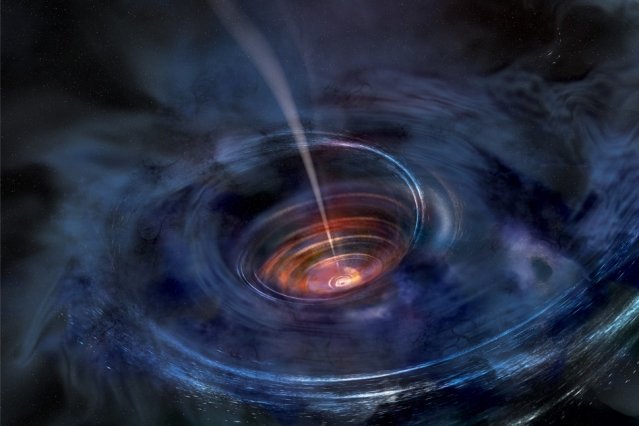
In this artist’s rendering, a thick accretion disk has formed around a supermassive black hole following the tidal disruption of a star that wandered too close. Stellar debris has fallen toward the black hole and collected into a thick chaotic disk of hot gas. Flashes of X-ray light near the center of the disk result in light echoes that allow astronomers to map the structure of the funnel-like flow, revealing for the first time strong gravity effects around a normally quiescent black hole. Credit: NASA/Swift/Aurore Simonnet, Sonoma State University
Scientists have identified a black hole that is “choking” on a sudden influx of stellar debris, a discovery that could lead to a better understanding of black holes.
Researchers from the Massachusetts Institute of Technology and NASA’s Goddard Space Flight Center have discovered a “tidal disruption flare”—a dramatic burst of electromagnetic activity that occurs when a black hole destroys a nearby star—in the center of a distant galaxy about 300 million light years away.
Scientists first discovered the flare in 2014 and have since trained a variety of telescopes on the event to learn more about how black holes grow and evolve.
The research team examined data collected by two different telescopes and identified the pattern in the energy emitted by the flare. As the obliterated star’s dust fell into the black hole, the researchers discovered small fluctuations in the optical and ultraviolet bands of the electromagnetic spectrum.
The same pattern repeated itself 32 days later, although in the X-ray band.
The research team used simulations to infer that such energy “echoes” were produced because as a star migrated close to the black hole, it was quickly ripped apart by the black hole’s gravitational energy. The resulting stellar debris, swirling close to the black hole, collides with itself and gives off bursts of optical and UV light at the collision sites.
As it was pulled further in, the colliding debris heated up, producing X-ray flares in the same pattern as the optical bursts, just prior to the debris falling into the black hole.
“In essence, this black hole has not had much to feed on for a while, and suddenly along comes an unlucky star full of matter,” Dheeraj Pasham, the paper’s first author and a postdoc in MIT’s Kavli Institute for Astrophysics and Space Research, said in a statement. “What we’re seeing is, this stellar material is not just continuously being fed onto the black hole but it’s interacting with itself — stopping and going, stopping and going.
“This is telling us that the black hole is ‘choking’ on this sudden supply of stellar debris.”
According to Pasham, tidal disruption flares are a potential window into the universe’s “hidden” black holes, which are not actively accreting or feeding on material.
“Almost every massive galaxy contains a supermassive black hole,” Pasham said. “But we won’t know about them if they’re sitting around doing nothing, unless there’s an event like a tidal disruption flare.”




